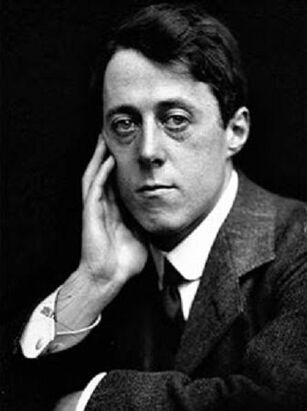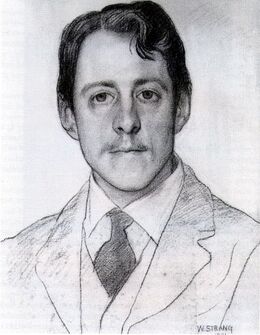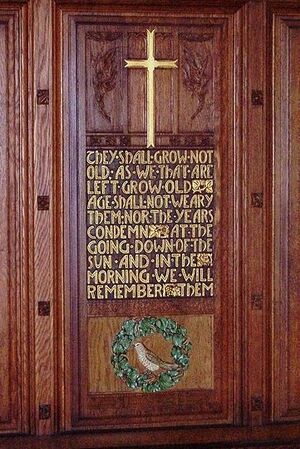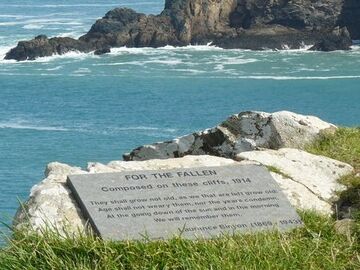
Laurence Binyon (1869-1943). Courtesy World War I and English Poetry.
Robert Laurence Binyon (10 August 1869 - 10 March 1943) was an English poet, playwright, and art scholar. His most famous work, "For the Fallen," is well known from being used in Remembrance Sunday services.
Life[]
Pre-war[]
Binyon was born in Lancaster, England. His parents were Frederick Binyon, a Quaker minister, and Mary (Dockray). His grandather, Robert Benson Dockray, was the main engineer of the railroad company of London and Birmingham. The family were Quakers.[1]
Binyon studied at St Paul's School. He then read classics at Trinity College, Oxford, where in 1890 he earned a 1st-class degree in classical moderations, and in 1892, a 2nd-class degree in litterae humainoires. In 1890 he also published 4 poems in a volume called Primavera: Poems by four authors, which included the work of 3 other young Oxford undergraduates (including his cousin, Stephen Phillips, who would also achieve a measure of fame as a poet.[2]
Immediately after graduating in 1893, Binyon began working for the Department of Printed Books of the British Museum, writing exhibition catalogs for the museum and art monographs for himself. In 1895 his earliest book, Dutch Etchers of the Seventeenth Century, was published. In that same year, Binyon moved into the Museum's Department of Prints and Drawings, under Campbell Dodgson.[1] In 1909, Binyon became its Assistant Keeper, and in 1913 he was made the Keeper of the new Sub-Department of Oriental Prints and Drawings.

Drawing of Laurence Binyon by William Strang (1859-1921), 1901. Courtesy Wikimedia Commons.
During this time Binyon played a crucial role in the development of Modernism in London by introducing young Imagist poets such as Ezra Pound, Richard Aldington, and H.D. to East Asian visual art and literature.[3] Many of Binyon's books produced while at the Museum were influenced by his own sensibilities as a poet, although some are works of plain scholarship - such as his four-volume catalogue of all the Museum's English drawings, and his seminal catalogue of Chinese and Japanese prints.
In 1904 he married historian Cicely Margaret Powell, and the couple had 3 daughters. During those years, Binyon belonged to a circle of artists, as a regular patron of the Wiener Cafe of London. His fellow intellectuals there were Sir William Rothenstein, Walter Sickert, Charles Ricketts, Lucien Pissarro, Ezra Pound, and Edmund Dulac.[1]
For the Fallen[]
- Main article: Ode of Remembrance

Ode of Remembrance on memorial plaque in Christ Church Cathedral, Christchurch New Zealand. Photo by Concord. Licensed under Creative Commons, courtesy Wikimedia Commons.
Moved by the opening of the Great War and the already high number of casualties of the British Expeditionary Force, in 1914 Laurence Binyon wrote his For the Fallen, with its Ode of Remembrance, as he was visiting the cliffs near Pentire Head in north Cornwall (where a plaque commemorates it nowadays.) The piece was published by The Times newspaper in September, when public feeling was affected by the recent First Battle of the Marne.
Today Binyon's most famous poem, For the Fallen, is often recited at Remembrance Sunday services in the UK, and is an integral part of Anzac Day services in Australia and New Zealand, and November 11 Remembrance Day services in Canada. The 3rd and 4th verses of the poem (although often just the 4th)[4] have so been claimed as a tribute to all casualties of war, regardless of nation.
- They went with songs to the battle, they were young.
- Straight of limb, true of eyes, steady and aglow.
- They were staunch to the end against odds uncounted,
- They fell with their faces to the foe.
- They shall grow not old, as we that are left grow old:
- Age shall not weary them, nor the years condemn.
- At the going down of the sun and in the morning,
- We will remember them.
In 1915, despite being too old to enlist in the First World War, Laurence Binyon volunteered at a British hospital for French soldiers, Hopital Temporaire d'Arc-en-Barrois, Haute-Marne, France, working briefly as a hospital orderly. He returned in the summer of 1916 and took care of soldiers taken in from the Verdun battlefield. He wrote about his experiences in For Dauntless France (1918) and his poems, "Fetching the Wounded" and "The Distant Guns", were inspired by his hospital service in Arc-en-Barrois.
Post-war[]
After the war, Binyon returned to the British Museum and wrote numerous books on art; in particular on William Blake, Persian art, and Japanese art. His work on ancient Japanese and Chinese cultures offered strongly contextualised examples that inspired, among others, the poets Ezra Pound and W.B. Yeats. His work on Blake and his followers kept alive the then nearly-forgotten memory of the work of Samuel Palmer. Binyon's duality of interests continued the traditional interest of British visionary Romanticism in the rich strangeness of Mediterranean and Oriental cultures.
In 1931, his 2-volume Collected Poems appeared. In 1932, Binyon rose to be the Keeper of the Prints and Drawings Department, yet in 1933 he retired from the British Museum.[1] He went to live in the country at Westridge Green, near Streatley (where his daughters also came to live during the Second World War). He continued further writing poetry.
In 1933-1934, Binyon was appointed Norton Professor of Poetry at Harvard. He delivered a series of lectures on The Spirit of Man in Asian Art, which were published in 1935. In May 1939 he gave the prestigious Romanes Lecture in Oxford on Art and Freedom. in 1940 he was appointed the Byron Professor of English Literature at University of Athens.; he worked there until forced to leave, narrowly escaping before the German invasion of Greece in April 1941.[1]
Binyon had been friends with Ezra Pound since around 1909, and in the 1930s the two became especially friendly -- ”Pound affectionately called him "BinBin", and closely assisted Binyon with his Dante translation work. Another Binyon protege was Arthur Waley, whom Binyon employed at the British Museum. Binyon also introduced Robert Frost to the young Robert Bridges.
Between 1933 and 1943, Binyon published an acclaimed translation of Dante's Divina commedia in an English version of terza rima. At his death he was also working on a major 3-part Arthurian trilogy, the 1st part of which was published after his death as The Madness of Merlin (1947).
He died in Reading, Berkshire, in 1943.
Family[]
His 3 daughters, Helen, Margaret and Nicolete, became artists. Helen Binyon (1904–1979) studied with Paul Nash and Eric Ravilious, illustrating many books for the Oxford University Press, and was also a marionettist. She later taught puppetry and published Puppetry Today (1966) and Professional Puppetry in England (1973). Margaret Binyon wrote children's books, which were illustrated by Helen. Nicolete, as Nicolete Gray, was a distinguished calligrapher and art scholar.[5]
Recognition[]

Memorial plaque to Binyon, New Polzeath, Cornwall. Photo by Paul Harvey. Licensed under Creative Commons, courtesy Geograph.org.
As a student at Oxford, Laurence Binyon won the Newdigate Prize for poetry in 1891 for his 1890 poem Perspephone.
2 of his poems, "Invocation to Youth" and "O World, be Nobler", were included in the Oxford Book of English Verse 1250-1900.[6] [7]
There is a slate memorial at St. Mary the Virgin Church, Aldworth, Berkshire, where Binyon's ashes were scattered after death.[8]
On November 11, 1985, Binyon was among 16 Great War poets commemorated on a slate stone unveiled in Westminster Abbey's Poet's Corner.[9] The inscription on the stone was written by a fellow Great War poet, Wilfred Owen. It reads: "My subject is War, and the pity of War. The Poetry is in the pity."[10]
In popular culture[]
Sir Edward Elgar set to music 3 of Binyon's poems ("The Fourth of August", "To Women", and "For the Fallen", published in the collection The Winnowing Fan) as The Spirit of England, Op. 80, for tenor or soprano solo, chorus and orchestra (1917).
Charles Villiers Stanford wrote incidental music for Binyon's play Attila in 1907.
Publications[]
Poetry[]
- Persephone: The Newdigate poem, 1890. Oxford, UK: Blackwell, 1890. London: Simkin Marshall, 1890.
- Primavera: Poems by four authors (Laurence Binyon, Arthur Shearly Cripps, Manmohan Ghose, Stephen Phillips). Oxford, UK: Blackwell, 1890.[11]
- Lyric Poems. London: Elkin Mathews, 1894.
- Poems. Oxford, UK: Daniel, 1895.
- First Book of London Visions. London: Elkin Mathews, 1896.
- The Praise of Life.London: Elkin Mathews, 1896.
- Porphyrion, and other poems. London: Grant Richards, 1898.
- Elkin Matthews, 1907.[12]
- Second Book of London Visions. London: Elkin Mathews, 1899.
- Odes. London: Unicorn Press, 1901; London: Elkin Mathews, 1913.
- The Death of Adam, and other poems. London: Methuen, 1904.
- Dream Come True. London: Eragny Press / New York: John Lane, 1905.
- Penthesilea: A poem. London: Constable, 1905.
- London Visions. London: Elkin Mathews, 1908.
- England, and other poems. London: Elkin Mathews, 1909.
- Auguries. London: Heinemann, 1913.
- The Winnowing Fan: Poems on the Great War. London:Elkin Mathews, 1914.
- The Anvil. London: Elkin Mathews, 1916.
- For the Fallen, and other poems. London: Hodder and Stoughton, 1917.
- The Cause: Poems of the war. Boston: Houghton Mifflin, 1917.
- The New World: Poems. London: Elkin Matthews, 1918.
- The Four Years: War poems collected and newly augmented. London: Elkin Mathews, 1919.
- The Secret: Sixty poems. London: Elkin Mathews, 1920.
- Selected Poems of Laurence Binyon. New York: Macmillan, 1922.
- The Sirens: An ode. London: Macmillan, 1925.
- Laurence Binyon. London: Ernest Benn, 1926.
- The Wonder Night (drawings by Barnett Freedman). London: Faber & Gwyer, 1927.
- The Idols: An ode. London: Macmillan, 1928.
- Collected Poems of Laurence Binyon. London: Macmillan, 1931. Volume I: Lyrical poems, Volume II: London visions, narrative Poems, translations.
- Three Poems. Derby, UK: Hampden Press, 1934.
- The North Star, and other poems. London: Macmillan, 1941.
- The Burning of the Leaves, and other poems. 1944.
- The Madness of Merlin (edited by Gordon Bottomley). London: Macmillan, 1947.
Plays[]
- Paris and Oenone: A tragedy in one act. London: Constable, 1906.
- Attila: A tragedy in four acts. London: John Murray, 1907.
- Bombastes in the Shades: A play in one act. London & New York: Oxford University Press, 1915.
- Arthur: A tragedy. London: Heinemann, 1923.
- Ayuli: A play in three acts and an epilogue. New York: D. Appleton, 1924.
- Boadicea: A play in eight scenes. London: Ernest Benn, 1927.
- Sophro the Wise: A play for children. London: Ernest Benn, 1927.
- Three Short Plays: Godstow nunnery, Love in the desert, Memnon. London: Sidgwick & Johnson, 1930.
- The Young King: A play. London: Macmillan, 1935.
- Brief Candles (with six engravings by Helen Binyon). London: Golden Cockerel, 1938.
Non-fiction[]
- Dutch Etchers of the Seventeenth Century. London: Seeley / New York: Macmillan, 1895.
- The Art of Botticelli: An essay in pictorial criticism. London: Macmillan, 1913.
- Masterpieces of Ething: 120 examples. London: Gowans & Gray, 1914.
- For Dauntless France: An account of Britain's aid to the French wounded and victims of the war. London & New York: Hodder & Stoughton, 1918.
- Tradition and Reaction in Modern Poetry. Oxford, UK: Oxford University Press, 1926.
- Art and Modern Life. Bristol, UK: J.W. Arrowsmith, 1929.
- "Gerard Hopkins and his influence". University of Toronto Quarterly, 8:3 (April 1939)
- Art and Freedom. (The Romanes lecture, delivered 25 May 1939). Oxford: Clarendon, 1939.
Biography[]
- William Strang. London: F. Keppel, 1904.
- Crone and John Sell Cotman. London: Seeley / New York: Macmillan, 1897.
- Akbar. New York: D. Appleton, 1932.
- The Case of Christopher Smart. London: Humphrey Milford / Oxford University Press, 1934.
English art[]
- William Blake: Being all his Woodcuts Photographically Reproduced in Facsimile (1902)
- English Metal Work. New York: John Lane, 1906; London: Archibald Constable, 1906.[13]
- Pre-Raphaelitism: Lectures on art. London: J.M. Dent, 1906; New York: E.P. Dutton, 1906.[14]
- English Poetry in its relation to painting and the other arts. London: Published for the British Academy by Humphrey Mlford & Oxford University Press, 1918.
- The Drawings and Engravings of William Blake. London: The Studio, 1922.
- The Followers of William Blake. London: Halton & T. Smith / New York: Minton, Balch, 1925; New York: B. Blom, 1968.
- The Engraved Designs of William Blake. 1926; New York: Da Capo, 1967.
- Landscape in English Art and Poetry. London: Cobden-Sanderson, 1931.
- English Water Colours. A. & C. Black, 1933; New York: Iris Books, 1939; New York: Schocken, 1969.
Asian arts[]
- Painting in the Far East. London: Edward Arnold, 1908; New York: Longmans, 1908; New York: Dover, 1959.
- Japanese Art. London & Leipzig: T.F. Unwin, 1909.
- The Flight of the Dragonan: an essay on the theory and practice of art in China and Japan, based on original sources. London: John Murray, 1911.
- The Court Painters of the Grand Moguls. London: Humphrey Milford / New York: Oxford University Press, 1921.
- Japanese Colour Prints. Ernest Benn, 1923; Boston: Boston Book & Art Shop, 1960.
- Examples of Indian Sculpture at the British Museum. London: India Sociey, 1923.
- Remains of a T'ang Painting Discovered by Sir Aurel Stein. London: H. Relach, 1925.
- Asiatic Art in the British Museum. Paris & Brussels: G. Van Oest, 1925.
- Chinese Paintings in English Collections. Paris & Brussels: G. Van Oest, 1927.
- Persian Miniature Painting. 1933; New York: Dover, 1971.
- Chinese Art. London: Kegan Paul, Trench, Trubner, 1935.
- Art of the Far East: Paintings from China and Japan. London: B.T. Batsford, 1936.
- The Spirit of Man in Asian Art. 1936; New York: Dover, 1965.
Translated[]
- Little Poems from the Japanese, rendered into English verse. Leeds, UK: Swan Press, 1925.
- Dante: Episodes from The Divine Comedy. London: Ernest Benn, 1928.
- The Poems of Nizami. London: The Studio, 1928.
- Koya San: Four poems from Japan. London: Red Lion Press, 1932.
- Dante's Purgatorio. London: Macmillan, 1938.
- The Portable Dante: The Divine Comedy, complete. New York: Viking Press, 1947.
Collected editions[]
- A Laurence Binyon Anthology. London: W. Collins, 1927.
Except where noted, bibliographical information courtesy WorldCat.[15]
See also[]

Laurence Binyon For the Fallen
References[]
- Checkland, Olive (2002) Japan and Britain After 1859: creating cultural bridges. London: RoutledgeCurzon ISBN 0-7007-1747-1
- Giddings, Robert (1998) The War Poets. London: Bloomsbury ISBN 0-7475-4271-6.
- Hatcher, John (1995) Laurence Binyon: poet, scholar of East and West. Oxford: Clarendon Press ISBN 0-19-812296-9
- Qian, Zhaoming (2003) The Modernist Response to Chinese Art: Pound, Moore, Stevens. Charlottesville: University of Virginia Press ISBN 0-8139-2176-7
Notes[]
- ↑ 1.0 1.1 1.2 1.3 1.4 http://www.dictionaryofarthistorians.org/binyonl.htm
- ↑ Laurence Binyon 1869-1943, Poetry Foundation. Web, Feb. 27, 2020.
- ↑ Arrowsmith, Rupert Richard (2010). Modernism and the Museum: Asian, African, and Pacific Art and the London Avant-Garde. Oxford University Press. pp.103-164. ISBN 9780199593699
- ↑ "Ode of Remembrance". Fifth Battalion The Royal Australian Regiment Official Website. Archived from the original on 2007-03-13. http://web.archive.org/web/20070313110108/http://5rar.asn.au/ode.htm. Retrieved 2007-06-12. "Titled; For the Fallen, the ode first appeared in The Times on September 21, 1914. It has now become known in Australia as the Ode of Remembrance, and the verse in bold above is read at dawn services and other ANZAC tributes."
- ↑ John Hatcher, "Binyon, (Robert) Laurence (1869–1943)", Oxford Dictionary of National Biography, Oxford University Press, 2004 accessed 25 Aug 2008
- ↑ "Invocation to Youth". Arthur Quiller-Couch, editor, Oxford Book of English Verse 1250-1900 (Oxford, UK: Clarendon, 1919). Bartleby.com, Web, May 14, 2012.
- ↑ "O World be Nobler". Arthur Quiller-Couch, editor, Oxford Book of English Verse 1250-1900 (Oxford, UK: Clarendon, 1919). Bartleby.com, Web, May 14, 2012.
- ↑ "Laurence Binyon," FindaGrave.com, Web, Nov. 13, 2011.
- ↑ http://net.lib.byu.edu/english/wwi/poets/poets.html
- ↑ http://net.lib.byu.edu/english/wwi/poets/Preface.html
- ↑ Primavera: poems (1890), Internet Archive, Web, June 23, 2012.
- ↑ Porphyrion and other poems (1907), Internet Archive, Web, June 23, 2012.
- ↑ English metal work (1906), Internet Archive, Web, June 23, 2012.
- ↑ Pre-Raphaelitism: Lectures ... (1906), Internet Archive, Web, June 23, 2012.
- ↑ Laurence Binyon, WorldCat, OCLC Online Computer Library Center Inc. Web, July 6, 2013.
External links[]
- Poems
- "In the High Leaves of a Walnut" at Your Daily Poem.
- "Koya San"
- Laurence Binyon in the Oxford Book of English Verse 1250-1900: "Invocation to Youth", "O World be Nobler"
- 3 poems by Binyon: "Summer Night," "First Day of Summer," "For the Fallen"
- Binyon, Laurence (1869-1943) - Biography & 4 poems (Angered Reason, For the Fallen, The Reformer, Stonehenge) at Representative Poetry Online
- Laurence Binyon at Wikisource
- Robert Laurence Binyon at PoemHunter (413 poems)
- Books
- Works by Laurence Binyon at Project Gutenberg
- Works by Laurence Binyon at Internet Archive
- Laurence Binyon at Amazon.com
- About
- Laurence Binyon in the Encyclopædia Britannica
- Laurence Binyon at Spartacus Educational
- Laurence Binyon (1869-1943) at the Victorian Web
- Laurence Binyon at Find a Grave
| This page uses Creative Commons Licensed content from Wikipedia. (view article). (view authors). |
|